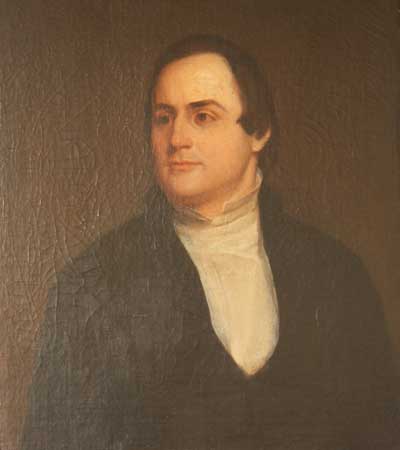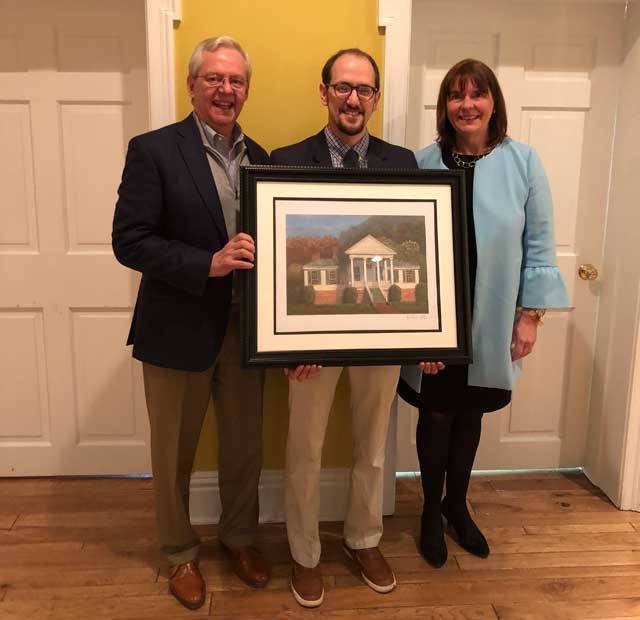Preservation & Restoration
Special Note: Because of the numerous visionary and dedicated leaders who made the historical Craik-Patton House a reality, this article focuses, not on individual names, but on the results of their collective achievement – the preservation and restoration of the Craik-Patton House, the architectural gem of Charleston, West Virginia. (Link to Craik-Patton House website.)
The Craik-Patton House, originally named “Elm Grove”, is a landmark federalist period Greek Revival house in Charleston, West Virginia. Two distinguished families lived in the house: those of James Craik, the grandson of George Washington’s close personal friend and doctor; and later, those of Colonel George S. Patton, who founded the Kanawha Riflemen during the Civil War. His grandson continued the family tradition of military leadership in the second World War.
 James Craik
James CraikThe house was built in 1834 on Virginia Street by attorney James Craik and his wife Juliet Shrewsbury. James Craik would later become a clergyman serving Charleston’s St. John’s Episcopal Church. In 1858 the house was purchased by Colonel George Patton, who died of wounds during the Civil War. In 1906, the house was moved from its riverfront location to Lee Street to make way for a new Charleston Street. When the house faced demolition in the 1960s because of commercial development, the National Society of Colonial Dames of America (NSCDA) in the State of West Virginia spearheaded a campaign to save and restore the house. In 1973 the Craik-Patton House was moved to its current location in Daniel Boone Park in Charleston.
Early Charleston
In the 1830s, a saw mill began operating and the more prosperous residents such as the Craik family could build clapboard homes with added rooms. The Craik-Patton House features a large central projecting section dominated by a portico supported by four Doric columns with two one-story wings that flank the central section at each side. An English basement raised the house to a level which would have alleviated the flooding prevalent at that time. The more usual local construction was that of log houses, an example of which stands next to the Craik-Patton house. In 1830, Charleston had a population of 1000 and stage coaches had begun to operate between Charleston and Lewisburg.
Craik and Patton Families
The Rev. James Craik’s grandfather, James Craik, traveled with George Washington during his survey work, much of it in what is now West Virginia. Following the Revolutionary War, both men purchased lands in western Virginia and it was this inheritance that brought young James Craik to the Kanawha Valley. Also in his inheritance was the desk that George Washington willed to his friend; it remained in the possession of the Craik family until the early 1900s when it was returned to Mount Vernon. Because of this documented knowledge of the famous mahogany/satinwood Washington desk, generous donors presented a reproduction for the house. (This is the only reproduction piece in the house.) Originally, the kitchen may have been on the exterior of the property because of the danger of fire. The current house places the kitchen at the lower level, where there was evidence of a winter kitchen. In 1846, Rev. Craik, his wife, and their seven children left Charleston when he was chosen to lead a new Episcopal Church in Louisville, Kentucky.
Colonel George Patton, grandfather of General George Patton of World War II fame, purchased the house in 1858. Col. Patton was a Virginia Military Institute graduate who later became a brigadier general in the Confederate army. He was killed in action in Winchester, Virginia in 1864. His widow left Charleston soon after to join family in California.
By the 1960s, the house had fallen into disrepair. The NSCDA leadership in West Virginia teamed up with leaders in Charleston city government to save the structure. Numerous architects and historians who were brought to the house recommended that the structure be preserved as a historical landmark because of its rich historic and architectural value. Lauded for its artistic simplicity in a Historical Buildings Survey, the house was listed on the National Register of Historic Places in 1970.
Visionary Leaders Help Preserve the Craik-Patton House
Without the teamwork and dedication of many visionary leaders, the Craik-Patton House would have been demolished. It is the only example of this type of Greek Revival architecture still standing in the Kanawha Valley. In 1973 the NSCDA in West Virginia joined the Charleston City Council to save the house. The city received a HUD matching grant for $42,500 from the federal government to be used for the purchase, relocation and restoration. The NSCDA in West Virginia matched the $42,500 grant using funds from their treasury and a gifts campaign. The first phase of the restoration work was nearing completion in 1975, and included moving the house in three parts to its new location; the roof even had to be removed to fit under a bridge.
The property became the headquarters of the NSCDA in West Virginia, maintained and operated by the Dames. The $85,000 project was one of the few attempts at that time in West Virginia to use federal funds for preservation of historical structures. The Kanawha-Charleston Regional Development Authority also helped coordinate the preservation effort with the Dames.
Museum Properties Established
With the move completed, the NSCDA in West Virginia started a massive refurbishing project and gradually filled the house with authentic Federalist period furnishings and decorative arts pieces. A few of the many antiques on exhibit are two Recamier sofas that belonged to the Craiks, family portraits, a poster bed, fine quilts, a robust Empire sideboard, objets d’art and a Gibson piano; many furnishings that belonged to local families were donated to the house, reflecting the times and styles of the families who lived there. Most of the wood floors are original to the house and the original mantel adorns the main parlor. All furnishings date from the early to mid-1800s.
Established as a museum house in the 1980s, visitors get a realistic glimpse of early 19th century life when every item in a house was handmade: candles and oil lamps were the source of light; cloth was spun on a spinning wheel; water was pulled up in a bucket from a well; travel was by horse and buggy; food had to be dried or salted to be preserved; and writing was done with a quill pen.
On the Craik-Patton House tours, docents tell the interesting stories about the Craik and Patton families in each of the rooms, making the house a living history and one of the true gems of Charleston, West Virginia.
Paul Zuros served as director from 2013-2017. He then accepted a position with the West Virginia Humanities Council to assist with their website and serve as house manager.
Nathan Jones is the current house director of the Craik-Patton Museum House.
 President of the Craik-Patton Board of Directors, Steve Roberts, is featured with Jessica Graney, NSCDA-WV President, presenting Zuros with a photograph of the Craik-Patton House
President of the Craik-Patton Board of Directors, Steve Roberts, is featured with Jessica Graney, NSCDA-WV President, presenting Zuros with a photograph of the Craik-Patton House.
